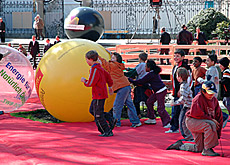
Scientists touch base with the public

To mark its 150th anniversary, Zurich’s Federal Institute of Technology is staging an exhibition that invites visitors to explore the world of science.
The centrepiece of special events in the anniversary year, it aims to give visitors an understanding of science and to illustrate its impact on people’s everyday lives.
World of Knowledge – on show in the park behind the Swiss National Museum in Zurich – has turned a visit to the Platzspitz park into an interactive experience.
“It is an experience exhibition [because] you can get a feel for science and what it is about by watching, touching and smelling – it is not abstract or theoretical at all,” Rolf Probala, the head of Corporate Communications at Zurich’s Federal Institute, told swissinfo.
Probala said that the exhibition was not aimed at specialists but at members of the public interested in getting an insight into science and the latest research projects.
Concept
The main idea behind the exhibition is to offer science and society the opportunity to come together, according to Probala.
The aim is to give ordinary people an opportunity to learn more about science, but also to get into conversation with scientists.
“The main goal is to show and explain what we do, to listen to our visitors, and then of course also to convince them that their money is well invested,” Probala explained.
Bringing science to society in this approachable and relaxed setting is the real strength of World of Knowledge, he says.
He added that thanks to the young scientists explaining their research projects and talking to people, the exhibition had turned out to be a great success.
Worlds of knowledge
On entering the exhibition, visitors find themselves surrounded by inflatable balls of different sizes and colours rolling around in the courtyard.
Probala explained that the balls were there for anybody to play with, but they also symbolised the world or the molecules and atoms composing the world.
“Models often show our world as balls, and the balls [in the courtyard] stand in a way for the different worlds of the exhibition,” he said.
Made up of five worlds – earth fire water air, man picture network, machines energy production, pipe dreams plans architecture, and books data knowledge – the exhibition offers the public an insight into a wide array of research areas from natural science to civil engineering.
The scientists aim to understand and answer questions regarding the Earth and the complex interrelationship between human beings and nature.
By studying stromatolites, for instance, the oldest microorganism still existing, researchers hope to find how oxygen originated on earth.
Man picture network gives an insight into the world of information technology by presenting the latest scientific achievements such as Lokomat, a walking robot that helps paraplegics learn to walk again, or Brain Trainer, an instrument for neurologists to learn more about and train important structures and functions of the brain.
Probala says earth fire water air, the largest world of knowledge comprising four tents, is of great interest to visitors, because they can easily relate to the topics.
“Committed researchers work in fields that are of importance for the world we live in and deal with key issues, such as sustainability, earthquakes and natural hazards or food and agriculture, that have a great impact,” Probala said.
Approaching the public
The two-week exhibition has proved popular with the public, attracting at least 100,000 visitors, according to Probala.
He added that the organisers had chosen the location because it was very central and because people were more likely to enter the park than to walk up to the Federal Institute of Technology.
“In a way it is up to scientists to approach the public, because you cannot expect people to come to science,” Probala explained.
He added that it was important to take science to the people because science and technology changed people’s lives and were a dominant factor in society, but also because knowledge was a driving force behind the economy.
For these reasons it is essential that scientists leave their ivory tower, meet and tell ordinary people what they do and allow them to have their say, ask questions and give their opinion, Probala says.
swissinfo, Katalin Fekete
World of Knowledge is one of many activities organised by Zurich’s Federal Institute of Technology to celebrate its 150th anniversary.
The exhibition, which runs in the Platzspitz park near the railway station until May 8, offers people the opportunity to talk to scientists and learn more about their latest research projects.
Apart from cultural and scientific events, the programme includes a series of short lectures given by the Institute’s teaching staff.

In compliance with the JTI standards
More: SWI swissinfo.ch certified by the Journalism Trust Initiative















![The four-metre-long painting "Sonntag der Bergbauern" [Sunday of the Mountain Farmers, 1923-24/26] had to be removed by a crane from the German Chancellery in Berlin for the exhibition in Bern.](https://www.swissinfo.ch/content/wp-content/uploads/sites/13/2025/12/01_Pressebild_KirchnerxKirchner.jpg?ver=a45b19f3)













You can find an overview of ongoing debates with our journalists here . Please join us!
If you want to start a conversation about a topic raised in this article or want to report factual errors, email us at english@swissinfo.ch.